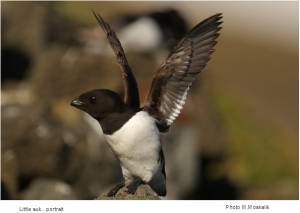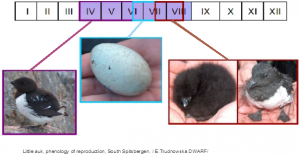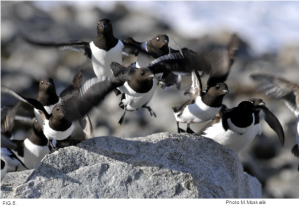Little auk: description, reproduction and individual development
Description
- length: approximately 20 cm
- body weight: 160- 200 g
- wingspan: approximately 40 cm
Coloration
The little auk has no characteristic gender differentiation (dimorphism). Plumage on both males and females is black and white. During the breeding season (early spring), birds of both sexes are black, except for some patches of white on their belly and undertail, a white bar on their wings and above their eyes, as well as few bright feathers on their back.
Outside of the breeding season, the chest, neck and throat are also white. Juveniles’ plumage is similar in pattern to the adults’ non-breeding season plumage, except that instead of black their plumage is a bronze colour. They have relatively short wings, which is an adaptation that helps them to dive. They fly with fast, quick movements, sometimes gliding.
There is no available statistical data on life expectancy. The oldest known individual the species lived to be about 16 years old.
Individual development / reproduction
Little auks form permanent monogamous pairs. Year after year they return to the same colony, and often to the same nest. They arrive in breeding areas in the south of Spitsbergen (Hornsund region) of Svalbard, Norway in mid-April, when the mountain slopes are still covered with snow, and they wait for adequate conditions to start a colony.
The female lays one, very large egg, rwhich can reach up to 30% of the bird’s body weight.
The incubation period for an egg is about 29 days, after which the chick is cared for, until it learns to fly, which is about a month. (FIG.1.).
A breeding pair divides its parental duties equally. Both take care of brooding and feeding. A few days before chick’s departure from the nest, the female leaves the nest and does not return until the beginning of the next breeding season. This behaviour is not yet fully understood, yet it is believed that this is compensation for the effort of the female body after producing the egg. All the birds leave the breeding colonies by mid-August.
Little auks play a very significant role in the circulation of organic matter in the coastal tundra ecosystem. It was determined that in the area of the research station of Hornsund, one colony of about 50,000 breeding pairs provides the area around the colony with about 100 tons of excrements each season.





 This project (EDU-ARCTIC) has received funding from the European Union’s Horizon 2020 research and innovation programme under grant agreement No 710240. The content of the website is the sole responsibility of the Consortium and it does not represent the opinion of the European Commission, and the Commission is not responsible for any use that might be made of information contained.
This project (EDU-ARCTIC) has received funding from the European Union’s Horizon 2020 research and innovation programme under grant agreement No 710240. The content of the website is the sole responsibility of the Consortium and it does not represent the opinion of the European Commission, and the Commission is not responsible for any use that might be made of information contained.